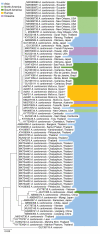Angiostrongylus cantonensis Nematode Invasion Pathway, Mallorca, Spain
- PMID: 35608603
- PMCID: PMC9155863
- DOI: 10.3201/eid2806.212344
Angiostrongylus cantonensis Nematode Invasion Pathway, Mallorca, Spain
Abstract
Neural angiostrongyliasis is an emerging zoonosis caused by the rat lungworm, Angiostrongylus cantonensis. In humans, infection with this nematode often results in eosinophilic meningitis and other severe disorders of the central nervous system. Europe was deemed a nonendemic region until 2018, when A. cantonensis worms were detected on the Mediterranean island of Mallorca, Spain, a tourism hotspot. Since that time, a sentinel surveillance system and a molecular approach have been used to follow the invasion path of the rat lungworm on the island. A. cantonensis worms have been found in animals from 8 locations on the island over 3 consecutive years. Our preliminary results show a recognizable pattern of clinical signs in infected hedgehogs and a single mitochondrial haplotype circulating in Mallorca. We present strong evidence confirming that the rat lungworm has successfully established and colonized an island in Europe and discuss observations and possible strategies for its early detection across continental Europe.
Keywords: Angiostrongylus cantonensis; Mallorca; Spain; angiostrongyliasis; animal diseases; central nervous system; hedgehogs; helminths; human eosinophilic meningitis; infection; invasion pathway; meningitis/encephalitis; nematodes; parasites; parasitic infections; rat lungworm infection; sentinel species; vector-borne infections; zoonoses.
Figures


References
Publication types
MeSH terms
LinkOut - more resources
Full Text Sources
Medical

